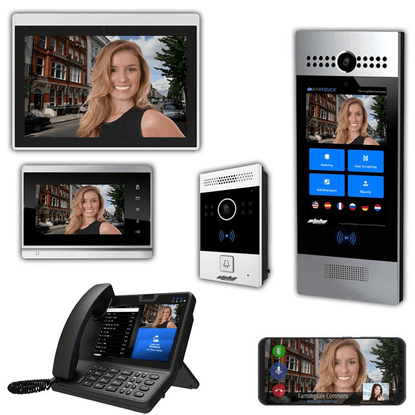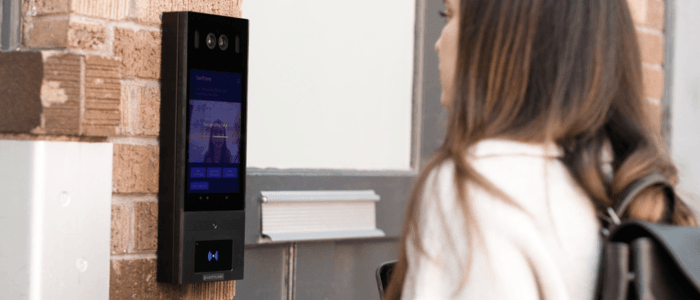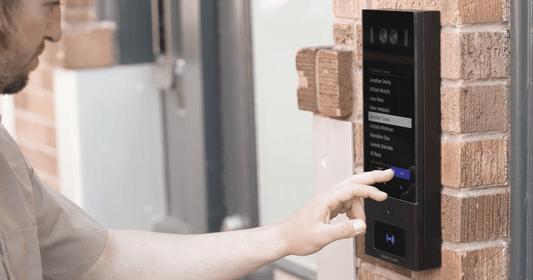Doorbell systems have evolved significantly over the years, transforming from simple wired doorbells to advanced wireless systems with video intercom capabilities. This guide aims to provide a comprehensive understanding of doorbells, their benefits, and disadvantages, as well as the differences between wired and wireless systems. Additionally, we will delve into the benefits of video intercom systems and introduce the best video intercom systems on the market.

Table of contents
- What Are Doorbell Intercom Systems?
- Advantages of Doorbell Intercoms
- Disadvantages of Doorbell Intercoms
- Wired vs. Wireless System
- Doorbells vs. Video Intercom Systems
- Benefits of Video Intercom Systems
- Best Video Intercoms for Apartments
- Top 3 Amenities Multifamily Residents Want
- How Does Swiftlane Work
Suggested posts
- The Best Apartment Intercom Systems (2023)
- Top Luxury Apartment Amenities: What Modern Renters Look For
- Apartment Intercom System: Ultimate Buyer’s Guide (2023)
- Intercom Systems: Become an Expert at Wired, Wireless, Video Intercoms
What Are Doorbell Intercom Systems?
A doorbell intercom system is a communication device that combines the functionality of a doorbell and an intercom to allow residents to speak with visitors at their front door without opening it. These systems provide an added layer of security and convenience to homeowners and residents by enabling them to verify the identity of visitors before granting access.
Doorbell intercom systems typically consist of the following components:
- Outdoor unit: The outdoor unit is installed at the entrance of the home or apartment and features a push button (doorbell), a microphone, and a speaker. When a visitor presses the doorbell button, it sends a signal to the indoor unit, alerting the resident.
- Indoor unit: The indoor unit is placed inside the apartment and consists of a speaker, a microphone, and a control panel or button to initiate communication with the visitor. Some indoor units may also include a display screen for video communication, while others may only provide audio communication.
- Power source: Doorbell intercom systems can be powered by batteries, an existing doorbell wiring, or a dedicated power source. Battery-powered systems offer greater installation flexibility but require periodic battery replacement or recharging, while wired systems typically provide a more stable power source but may require professional installation.
- Wiring or wireless connection: Doorbell intercom systems can either use wired connections between the outdoor and indoor units or communicate wirelessly. Wired systems may offer more reliable and secure connections but can be more difficult to install. Wireless systems provide easier installation and greater flexibility in placement but may be subject to interference from other wireless devices.
- Optional features: Some doorbell intercom systems may offer additional features such as video communication, integration with smart home systems, or remote access via a mobile app. These features can enhance security and convenience but may come with a higher price tag.

Doorbell intercom systems provide a practical and efficient solution for verifying visitors’ identities and communicating with them without compromising building security. They are particularly useful in apartment buildings, gated communities, and homes with limited visibility of the front entrance.
Advantages of Doorbell Intercom Systems
- Enhanced security: Doorbell intercom systems allow residents to verify the identity of visitors before granting access, reducing the risk of unauthorized entry and potential security threats.
- Improved convenience: Residents can communicate with visitors without having to physically open the door, which is particularly useful for individuals with mobility issues or when it’s not practical to open the door, such as during bad weather.
- Remote access: Some doorbell intercom systems can be integrated with mobile apps or smart home systems, enabling remote communication with visitors and granting access even when the resident is away from the property.
- Privacy: Doorbell intercom systems provide an additional layer of privacy by allowing residents to screen visitors without face-to-face interaction.
- Customizable features: Many doorbell intercom systems offer a variety of optional features such as video communication, motion detection, and integration with other security devices, allowing residents to tailor the system to their specific needs and preferences.
Disadvantages of Doorbell Intercom Systems
- Installation: Wired doorbell intercom systems may require professional installation, particularly if there is no existing wiring in place. This can add to the overall cost of the system.
- Wireless interference: Wireless intercom doorbell systems can be subject to interference from other wireless devices, potentially affecting the quality and reliability of the connection.
- Maintenance: Battery-powered systems require periodic battery replacement or recharging, which can be inconvenient and may cause temporary lapses in functionality.
- Cost: Doorbell intercom systems, particularly those with advanced features such as video communication and smart home integration, can be more expensive than traditional doorbells.
- Aesthetics: Some intercom doorbell systems may have a more utilitarian appearance than traditional doorbells, which may not be to everyone’s taste or complement the building’s exterior design.
Wired vs. Wireless Doorbell Intercom System
When it comes to doorbell intercom systems, there are two main options available: wired and wireless. Each type has its own set of advantages and disadvantages, making the choice between them largely dependent on individual needs and preferences. Here, we’ll discuss the differences between wired and wireless intercom doorbell systems to help make an informed decision.
Wired Doorbell Intercom System:
Advantages:
- Reliable connection: Wired systems offer a stable and consistent connection, with little to no risk of interference from other wireless devices.
- Continuous power: Wired intercom doorbell systems are connected to the building’s electrical supply, ensuring that they’re always powered and functional.
- Less maintenance: Wired systems do not rely on batteries, which means that they won’t need to be replaced or recharged periodically.
- Integration with existing wiring: If the building already has an existing wired doorbell system, it may be simpler and more cost-effective to upgrade to a wired intercom doorbell system.
Disadvantages:
- Installation: Wired systems generally require professional installation, especially if the building doesn’t already have the necessary wiring in place. This can be more expensive and time-consuming than a wireless system install.
- Limited flexibility: Wired systems can be more difficult to relocate or expand if needs change, as this may involve running additional wiring.
Wireless Doorbell Intercom System:
Advantages:
- Easy installation: Wireless systems are typically easier to be installed, as there’s no need to run wires. This makes them an attractive option for those who prefer a more flexible approach or for buildings without existing doorbell wiring.
- Flexibility: Wireless systems can be easily relocated or expanded. They are easily customized in order to meet potential changing needs.
- Remote access: Many wireless intercom doorbell systems can be integrated with smartphone apps or smart home systems, allowing residents to communicate with visitors and grant access from anywhere.
Disadvantages:
- Potential interference: Wireless systems can be subject to interference from other devices operating on the same frequency, which may cause issues with connectivity and reliability.
- Battery maintenance: Wireless intercom doorbell systems typically rely on batteries for power, which will need to be replaced or recharged periodically.
Doorbells vs. Video Intercom Systems
While doorbells primarily serve as signaling devices, video intercom systems take it a step further by allowing two-way communication between the occupants and visitors. Video intercom systems also provide live video footage, enabling users to see who is at the front door before deciding whether to grant access.
Benefits of Video Intercom Systems
- Enhanced Security: The video intercom offers an extra layer of security by allowing occupants to see and communicate with visitors without opening the door.
- Remote Access: Many video intercom systems allow users to access live video feeds and communicate with visitors remotely via smartphone apps, offering added convenience and peace of mind.
- Recorded Footage: Some video intercom systems provide the option to record footage, enabling users to review past interactions or incidents.
- Integration with Other Security Systems: Video intercom systems can often be integrated with other security systems, such as access control or alarm systems, for a more comprehensive security solution.
Best Video Intercoms for Apartments
The following is a list of the best video intercom systems for apartments, taking into consideration their features, ease of use, and overall performance.
1. Swiftlane Video Intercom for Apartments
Swiftlane offers a top-of-the-line video intercom system designed specifically for apartment buildings. It provides seamless and secure access control, along with a user-friendly interface.
Standout Features:
- Touchless entry using smartphones or access cards
- Two-way audio and video communication
- Remote access via mobile app
- Integration with other security systems
2. AlphaTouch Video Intercom System
Alpha Communication’s, AlphaTouch is a cloud-based multi-tenant video intercom platform that includes IP 65 rated water and dust resistant 7” touchscreen entry stations and 7” and 10” indoor monitors. The system runs Android based AlphaTouch firmware while the hardware is manufactured by Akuvox. Visitors can use a scrollable touchscreen directory to place video calls on indoor stations and smartphones running the AlphaTouch mobile application.

Alpha Touch Video Intercom- Source: Alpha Communications
Alpha Touch URL: https://www.alphacommunications.com/
Detailed Review: Alpha Communications AlphaTouch Pricing & Comparison
3. Latch Video Intercom System
Latch is a full building operating system that also includes two-way audio intercom built into its locking hardware. An external video camera needs to be installed to achieve video intercom and video monitoring functionalities. The system consists of an innovative entry station with tactile buttons and proprietary Latch door locks on each apartment door.
Latch Intercom- Source: Latch
Closer Look: Latch Intercom Overview & Pricing
Top 3 Amenities Multifamily Residents Want
Video Intercom Doorbell
More than 80% of the residents are strongly interested in video intercom and remote door unlock, to avoid package theft and handle visitors.
Secure, Keyless Access
- Secure access is rated as the #1 most desirable feature. Mobile access improves the safety and appeal of the buildings for residents and prospects.
Secure Package Management
- $5.4B worth of packages were stolen in 2020. 84% of residents want secure delivery access to eliminate packages being lost or stolen.
How Does Swiftlane Work?
Swiftlane smart access technology provides safer, more secure access solutions for multifamily communities using video intercom, face recognition access, mobile access, and visitor PINs. Swiftlane’s integrated video intercom system offers built-in two-way audio and video intercom calling for secure visitor and guest management. The Swiftlane app allows users to answer calls from anywhere, and they are received as a regular phone call without the need to monitor app push notifications. Traditional intercom systems only work when you are in the building.
- Pick up calls on mobile phone or computer
- Two-way video and audio intercom calling
- Multi-tenant video intercom
- Ensures secure delivery access and reduces package theft and unauthorized access
Designed to protect your investment
- SwiftReader X comes with IK10 rating, the highest rating for impact protection
- Ensures that your investment can last for decades to come
- Swiftlane also provides free vandal replacement insurance
- IP65 rated for weather protection
- Works in extreme heat and cold

Conclusion
In conclusion, doorbell intercom systems offer a practical and efficient solution for verifying visitors’ identities and communicating with them without compromising building security. By understanding the different types of doorbell systems, their benefits and disadvantages, as well as the distinctions between wired and wireless systems, individuals can make informed decisions when selecting the best solution for their needs. Video intercom systems, in particular, provide an added layer of security and convenience, as they allow for visual confirmation of visitors and seamless communication between residents and guests.
As technology continues to evolve, doorbell intercom systems are becoming more advanced and versatile, with features such as remote access, integration with smart home systems, and secure package management. By exploring the best video intercom systems available on the market, such as Swiftlane Video Intercom for Apartments, AlphaTouch Video Intercom System, Latch Video Intercom System, users can identify the most suitable option for their residential or commercial properties. Ultimately, a well-chosen doorbell intercom system can greatly enhance security, convenience, and overall quality of life for residents and property owners alike.
Get a Swiftlane Quote
Tell us about your building and we'll help you find the best solution.










